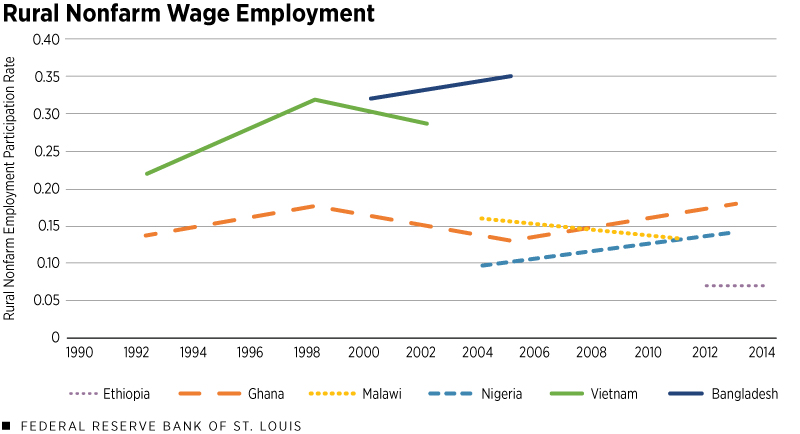Industrialization and Development in Sub-Saharan Africa
Per capita income in many nations in sub-Saharan Africa is much smaller than that of the U.S., according to data from the World Bank. Can industrialization spur economic growth in this region?
In a recent Regional Economist article, economist and Assistant Vice President Yi Wen and Research Associate Iris Arbogast, examined why poorer countries have had difficulties industrializing and also offered some insights into how sub-Saharan Africa can be successful with this type of development.
The New Stage Theory of Development
Using the New Stage Theory of Development,See Wen, Yi. The Making of an Economic Superpower: Unlocking China's Secret of Rapid Industrialization. World Scientific Publishing Co., 2016. Wen and Arbogast laid out three key stages that economies go through when successfully industrializing.
- Proto-industrialization, which is highlighted by numerous workshops in rural areas with small-scale manufacturing of basic consumer goods for long-distance trade
- A first industrial revolution, which is highlighted by mass production of labor-intensive, light consumer goods for domestic consumption and export
- A second industrial revolution, which is highlighted by mass production of capital-intensive, heavy industrial goods
Conventional Development Theories
Wen and Arbogast explained that the key aspect of this sequential developmental process is to gradually increase the size of the market, so it can support mass production of more sophisticated and capital-intensive industrial goods and thus take advantage of the economies of scale.
“This sequential process overcomes the problems associated with the lack of skilled workers, the scarcity of capital and barriers to technology adoption encountered by many developing countries at various developmental stages,” they wrote.
However, many development theories teach poor agrarian nations to focus on heavy industries like steel production and on setting up modern financial systems. This can lead to problems, such as large debts and financial crises, the authors noted.
Development and Sub-Saharan Africa
Such conventional theories have been used by sub-Saharan African countries as they attempted to industrialize after gaining independence from various European colonial powers. However, these theories have not resulted in successful outcomes, the authors observed
They pointed to Ghana as an example. After becoming independent from the U.K. in 1957, the country focused on state-owned, capital-intensive manufacturing to reduce import dependence and make technical progress. But the resulting industrialization didn’t help boost Ghana’s gross domestic product, which slowed in the 1960s, and an attempt to liberalize those state-owned industries in the 1980s didn’t achieve high levels of growth, they wrote.
Many sub-Saharan African countries appear not to have started or finished their proto-industrialization stage, Wen and Arbogast noted. They pointed to the relatively low share of farming households participating in nonfarm wage employment, which indirectly measures proto-industrialization. (See figure below.)

SOURCE: United Nations Food and Agriculture Organization RIGA database.
NOTES: The data show rural nonfarm wage employment over 22 years. While developing Asian countries such as Bangladesh and Vietnam have experienced notable increases in rural nonfarm employment, poorer African countries have not experienced such gains.
The figure shows newly emerging Asian economies like Vietnam and Bangladesh with about 30% of rural households were involved in nonfarm wage jobs in the early to mid-2000s. But in poorer African countries, these rates ranged from 5% to 18%, they observed.
Looking at China’s recent industrialization and British industrialization in the 18th and 19th centuries, Wen and Arbogast said proto-industries need to get to about 25% to 30% share of employment in the rural labor force to spark a first industrial revolution, which means profitably mass-producing light consumer goods and competing in global markets.
Vietnam and Bangladesh appear to have the market conditions for supporting mass-production technologies in light industries such as textiles, they noted, adding that both nations are in fact the largest clothing exporters after China. However, countries like Ethiopia, Ghana, Malawi and Nigeria do not seem ready to support mass-production technologies in light industries because their textile and clothing exports are very low, they pointed out.
Development Policy Suggestions
Wen and Arbogast posited that policymakers should focus on enhancing proto-industrialization, which will help put their nations on the healthy path of economic development.
“The goal is to absorb as many rural households as possible into small-scale manufacturing workshops to increase their income and create a primitive supply chain and a disciplined labor force,” they wrote. “This is one of the critical steps for nurturing a mass market to support full-fledged mass-production in light industries.”
To achieve this, government must provide the needed infrastructure and social capital to allow farmers to organize themselves into businesses and ship their products to distant markets, the authors noted. They added that part of the income earned by these farmers could be used to finance government initiatives, such as constructing local roads and canals.
“Successfully creating proto-industrial supply chains, commercial distribution networks and competition between proto-industrial firms would eventually help give rise to large firms that mass-produce light industrial goods such as textiles,” they wrote. “A nation can also be more likely to attract large foreign firms that outsource their labor-intensive manufacturing industries by using subsidization policies such as providing ports, roads and free land as incentives.”
Notes and References
- See Wen, Yi. The Making of an Economic Superpower: Unlocking China's Secret of Rapid Industrialization. World Scientific Publishing Co., 2016.
Citation
ldquoIndustrialization and Development in Sub-Saharan Africa,rdquo St. Louis Fed On the Economy, Sept. 14, 2021.
This blog offers commentary, analysis and data from our economists and experts. Views expressed are not necessarily those of the St. Louis Fed or Federal Reserve System.
Email Us
All other blog-related questions

